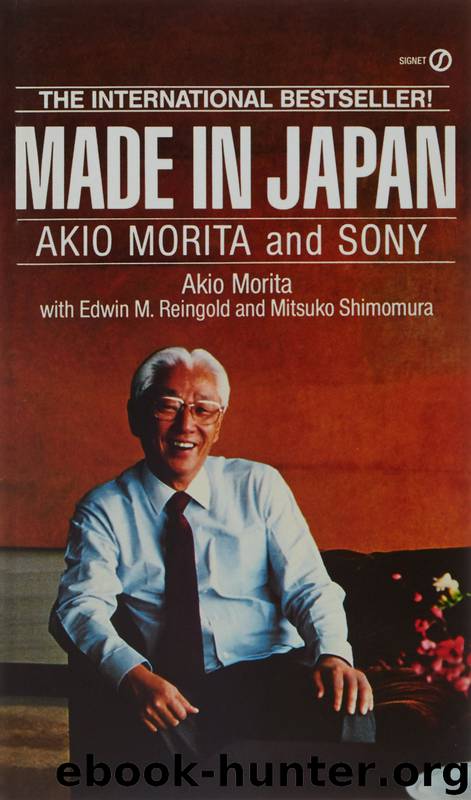Made In Japan by Akio Morita

Author:Akio Morita
Language: eng
Format: mobi
Published: 2017-05-07T04:00:00+00:00
III
Once you have a staff of prepared, intelligent, and energetic people, the next step is to motivate them to be creative. For a long time, the Japanese have been branded as imitators rather than creators. But I think it would be downright foolish to say that what Japanese industry has accomplished in the past forty years has been anything but creative. The work being done in biotechnology, new materials such as ceramics and fibers, optoelectronics, and other fields all speak for themselves. And certainly our contributions in production technology and quality control have been creative.
We all learn by imitating, as children, as students, as novices in the world of business. And then we grow up and learn to blend our innate abilities with the rules or principles we have learned. Dr. Makoto Kikuchi, our research center director, likes to point out that imitation is the first step in a child’s learning process and that the original meaning of the Japanese word manabu (to learn) is manebu (to imitate).
When Japan joined the world after more than two centuries in isolation, the Japanese were ignorant of so much that had been learned and developed abroad during those centuries. Led by the government and the enlightened leadership of the Emperor Meiji, Japan reached out all around the world for these “new” ideas and technologies. In a way this was done in self-defense, because when the Western countries demanded that Japan open its doors, they also imposed unequal treaties on Japan, pacts that did not allow Japan to protect her economy and infant industries. A strong industrial base together with a strong military seemed the only way to survive as a member of a rather greedy and predatory international society.
Some people think that the Japanese ability to create the country’s present industrial establishment is something that was learned in the four decades since World War II, but they just do not know their history. From the depths of agrarian isolation, Japan started on its industrial journey in the last third of the nineteenth century, and by 1905—only about one generation—the industrial and economic might of the nation had been raised to such a height that tiny Japan, with a population of about thirty million, was able to defeat both China (1894-95) and Imperial Russia (1904-1905) in war. At the beginning of World War I in Europe, Japan was the major military and industrial power in Asia. This is history, and I am citing it only to point out that the economic miracle of Japan since 1945 should be seen in perspective. Early in the development process the Meiji government realized it could devise economic plans and set industrial goals to fulfill the plans, but government leaders soon realized they could not run the factories and produce the goods. And so government and industry devised a system of cooperation and support, for the benefit of the nation. Some aspects of the system are being dismantled only today.
Comparing the two periods—the Meiji era and the post-
Download
This site does not store any files on its server. We only index and link to content provided by other sites. Please contact the content providers to delete copyright contents if any and email us, we'll remove relevant links or contents immediately.
Hit Refresh by Satya Nadella(8839)
The Compound Effect by Darren Hardy(8473)
Change Your Questions, Change Your Life by Marilee Adams(7344)
Nudge - Improving Decisions about Health, Wealth, and Happiness by Thaler Sunstein(7216)
The Black Swan by Nassim Nicholas Taleb(6739)
Deep Work by Cal Newport(6525)
Daring Greatly by Brene Brown(6211)
Rich Dad Poor Dad by Robert T. Kiyosaki(6157)
Principles: Life and Work by Ray Dalio(5919)
Man-made Catastrophes and Risk Information Concealment by Dmitry Chernov & Didier Sornette(5627)
Playing to Win_ How Strategy Really Works by A.G. Lafley & Roger L. Martin(5412)
Digital Minimalism by Cal Newport;(5355)
Big Magic: Creative Living Beyond Fear by Elizabeth Gilbert(5325)
The Myth of the Strong Leader by Archie Brown(5223)
The Slight Edge by Jeff Olson(5192)
Discipline Equals Freedom by Jocko Willink(5148)
The Motivation Myth by Jeff Haden(4983)
Stone's Rules by Roger Stone(4838)
The Laws of Human Nature by Robert Greene(4753)
